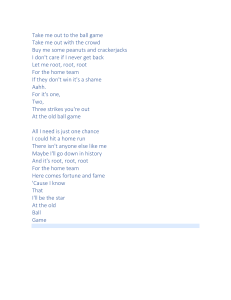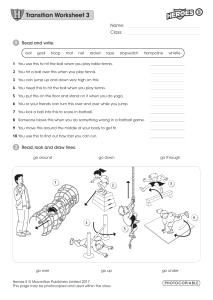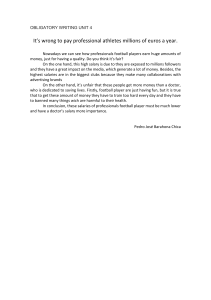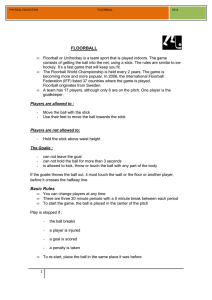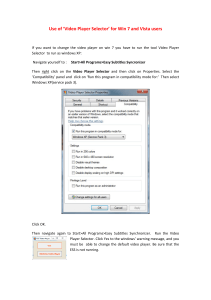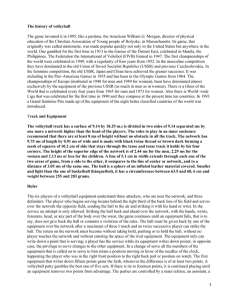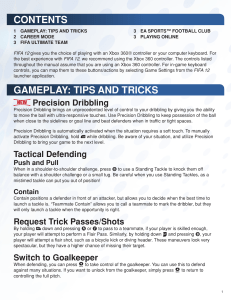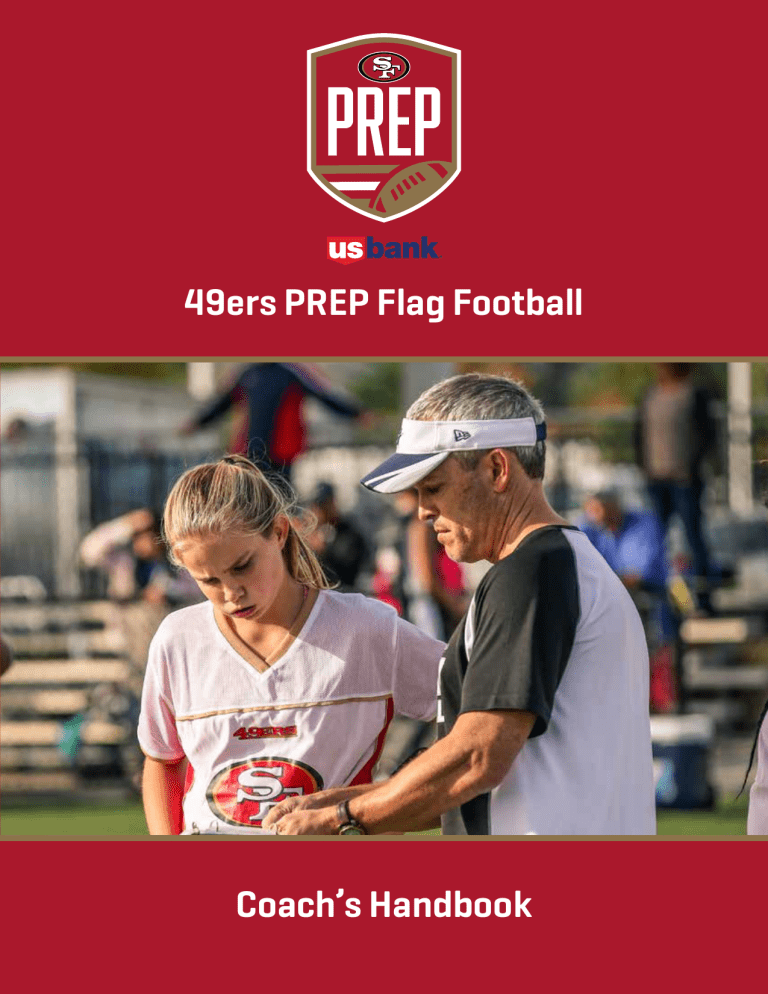
49ers PREP Flag Football Coach’s Handbook TABLE OF CONTENTS 4 7 8 9 10 League Goals Expectations Self-Assessment Coach’s Responsibilities 12 Coaching Tips Sample Practice Plan 14 Offensive & Defensive Drills 16 Rookie 22 Scarlet 28 Gold 32 33 Formations / Terminology Penalties 34 Checklist 35 Safety LEAGUE GOALS On behalf of the San Francisco 49ers Foundation, thank you for volunteering your time to make 49ers PREP Flag Football a fun, safe experience for young people. We believe it will be a fun and rewarding activity for you, as well. 49ers PREP’s flag football program provides boys and girls age 7-14 the chance to play flag football for free with 49ers PREP providing all the necessary equipment and structure. Host organizations are responsible for registration and field scheduling. We hope this handbook will provide you with all the tools you need as a coach but do not hesitate to reach out to your host organization if you need assistance. You are the key to the success of 49ers PREP. Children on your team will look up to you as a teacher, leader, role model, and authority figure. Don’t underestimate the influence, positive or negative, you can have upon a child. The team will take your lead and adopt your attitude. Below are four goals we hope to accomplish through this league: Improve Social Relationships You will create a positive social environment by having the participants work together as a team for a common goal. They need to rely on each other, so developing better ways to communicate will be key. 49ers PREP will provide coaches the tools (training, handbooks, etc.) to achieve these goals and become a great role model who encourages teamwork on and off the field. Appreciate Diversity 49ers PREP brings together children from a variety of economic, ethnic, and religious backgrounds. Participants from different neighborhoods, ages, gender, and skill levels all come together in a team-oriented environment. It’s your job as a coach to welcome all differences and celebrate diversity. Skill Development Through our trainings and the coach’s handbook, you will learn to focus on specific skills that contribute to the overall development and coordination of children. Player improvement in throwing, receiving, lateral movement, and route running will all be foci. Have Fun One of the most important aspects of 49ers PREP is fun. If games and practices are fun, children develop a positive attitude towards physical activity and a healthy attitude toward competition. 4 5 “Few things offer greater return on less investment than praise.” - Bill Walsh EXPECTATIONS Expectations of Coaches The Double-Goal Coach ® You determine the kind of experience our athletes have with sports. We expect you to be a Double-Goal Coach, who strives to win (one goal), while pursuing the more important goal of teaching life lessons through sports (the other goal). As a Double-Goal Coach you will: Model and teach your players to honor the game • Teach ROOTS when explaining how to honor the game. - Respect for Rules, Opponents, Officials, Teammates, and one’s Self. • Seize teachable moments to talk with players about honoring the game. Help players pursue mastery of their sport, not just scoreboard wins • Teach players the ELM Tree of Mastery - Effort, Learning, and bouncing back from Mistakes • Reward effort, not just good outcomes. Recognize players even for “unsuccessful” efforts (dropped ball or bad pass). •Encourage players to set goals and show them that their success is tied to how hard they try. Fill your players’ Emotional Tanks • Use encouragement and positive reinforcement as your primary method of motivating. • Achieve the “Magic Ratio” of five positive reinforcements to each criticism or correction. • Encourage players to fill each other’s Emotional Tanks by acknowledging each other’s efforts. Have team meetings with your players at every practice and game • Review honoring the game, the ELM Tree and the Emotional Tank throughout the season. • Ask questions and encourage players to speak and contribute during team meetings. Adopting these philosophies and actions will contribute to a positive, character-building youth sports experience for all the children our organizations serve. Thank you for all your time and effort! For more resources and definitions, visit: www.PCADevZone.org For more information on Positive Coaching Alliance, visit: www.PositiveCoach.org 6 7 SELF-ASSESSMENT Double Goal Coach Self-Assessment Coach’s Responsibilities A Double-Goal Coach never loses sight of the unique opportunity to use sports as an avenue to teach important life-skills such as hard work, fair play, teamwork, resilience, delayed gratification, and how to compete fiercely with class. A Double-Goal Coach also realizes that a coach’s words and actions – good or bad – can be remembered for a lifetime. Assess yourself on each of the statements below using a 1-5 scale: (1 = Never, 2 = Seldom, 3 = Sometimes, 4 = Often, 5 = Always). Coaches Meeting / Orientation Honor the Game 1. I teach my players to show respect for the Rules, Opponents, Officials, their Teammates, and one’s Self (ROOTS). 2. I seize the opportunity to talk with my players about upholding team standards and intervene in situations that conflicts with 49ers PREP policies. 3. I model the type of behavior and attitude I want to see from my players both as a coach and out in the community. Coach for Mastery of Sport, not just scoreboard wins 4. I teach players to focus on mastery through providing maximum effort, continuously learning, and bouncing back quickly from mistakes. 5. I will encourage players to stay positive and remind them of their value to the team to help them quickly rebound from mistakes. 6. I reward effort, not just good outcomes. I recognize players even for “unsuccessful” efforts. Coach for Mastery of Sport, not just scoreboard wins 7. I use encouragement and positive reinforcement as my primary method of motivating. 8. I seek to achieve the “Magic Ratio” of five specific and truthful pieces of positive reinforcements for every specific, constructive criticism or correction. 9. I ask questions and encourage players to speak and contribute during team meetings. 8 COACH’S RESPONSIBILITIES Thank you for volunteering to coach! As a reminder, there will be a coaches meeting regarding 49ers PREP. At this meeting, we will discuss a variety of topics including: • Recreational Sports Philosophy • Sportsmanship • League rules • Practice schedules • Roster distribution • Game schedules, game locations, etc. Coach Pre-Season Preparations Set-up a team meeting with your families before the first practice. Below you will find an example of a few key elements you can include in your agenda. Sample Parent/Guardian Meeting Agenda Welcome & Introduction Share how excited you are about the upcoming season and having their children on your team. Share some of your relevant background as an athlete, coach, and/or parent. Coaching Philosophy Share your values as a Double-Goal Coach. Distribute the 49ers PREP Parent/Player Handbook that covers 49ers PREP policies and expectations. Discuss these principles in, asking for questions on each before you go on to the next. Ask for parents’ support in building a team culture that will reinforce those principles. Discuss scenarios, such as “What if the official makes a questionable call against our team?” Remember, you will set a good example for the players by always remembering to honor the game. Share your policy on playing time, missing practice, etc. For example, if missing practice means less playing time, tell parents in this meeting. You can avoid problems later by being clear now. Inform parents of the most efficient way to contact you (e.g., by e-mail, at work during the day, only in evenings). Logistics Make sure everyone has practice and game schedules, contact information, and equipment lists. Leave plenty of time for questions. Ask for Help Ask parents to help in a variety of roles such as snack coordinator or carpool arranger. 9 COACHING TIPS Flag Football Coaching Tips Whether this is your first experience coaching or you are a veteran, we hope you will find the following information helpful in providing a framework for making your coaching experience this season a successful one. 1. Season Plan: Have a game plan for yourself, your assistant coaches, your players and parents. Make sure you keep it focused and you set the proper expectations prior to your first practice. 2. First Practice: This is your most important practice of the season. This practice will set the tone for your players, coaches and parents. Make sure it is organized, has high energy and everyone is involved. Have a fun game or drill to end practice that everyone will remember. 3. Drills: What drills will your players need to work on to implement your offensive and defensive game plans? Put these together in a logical order starting from very basic fundamental drills to more complex. Drills will help your players improve their game and your strategy. 4. Time Management: The most difficult task for any coach. You never have enough time to run through all the plays, practice every drill and cover each possible play your opponent may run. Now is the time for coaches to look at ways you can improve your coaching and maximize your time effectively. 10 11 SAMPLE PRACTICE PLAN This is a basic guide for your first week of practice. Feel free to modify however you see fit. Passing Warm-Up (10 minutes) Introductions (5 - 10 minutes) Have players split into groups of three or four. Have them stand around 10 yards apart (adjust the distance for different age groups). Have the players begin throwing the football to one another to warm up their arms. Take a few minutes to get to know your team. Form a circle, and go around the circle having each child introduce themselves and provide some basic information (such as which school they go to, share their favorite NFL team, name their favorite NFL player). Let your team know a little about yourself. Warm-Ups (5 - 10 minutes) Use this opportunity to demonstrate proper passing and receiving techniques. For passing, each player should stand with the shoulder of his non-throwing arm pointed directly at his target. The ball should be held high Have your players go for a brief jog in an orderly fashion. Stress that itʼs not a race and they should run at an easy pace. When they are finished, have them circle up and go through 8-10 basic stretches such as toe touches, quad stretches (flamingos), butterfly stretch, arm circles, etc. Your team can also help identify stretches that work for them. For receiving, make sure that players are catching the ball with their hands, and not trapping it against their body. For balls received above the waist, the playerʼs thumbs and index fingers should touch, forming a diamond. For footballs received below the waist, the player’s pinkies should touch. Snapping the Ball (10 minutes) Break (2 minutes) Each play begins with a snap, so this is an important skill to master. Begin by demonstrating the proper technique involved in snapping the football with the quarterback under center. Proper technique begins with the center grasping the ball in a similar fashion in which he would to throw a pass. The centerʼs feet should be slightly more than shoulder with apart and his knees should be bent. Have the player grab a quick drink and set up for your next drill The center executes the snap on the quarterback’s signal (set - hike, or whatever cadence you choose). The snap is performed by lifting the ball back towards the quarterback while rotating the wrist 90 degrees. The laces of the football should be parallel to the ground when the quarterback receives the ball. Have each player perform a few under-center snaps with players rotating at quarterback. The shotgun snap starts in the same way, with the center’s feet slightly more than shoulder width apart, knees bent, and grasping the ball much like he was going to execute a pass. The quarterback should be five to seven yards back. Have the center look at his target between his legs, and execute the shotgun snap on the quarterbackʼs signal. The shotgun snap is, in essence, the center throwing a pass to the quarterback. Have each player perform a few shotgun snaps, with players rotating at quarterback. Basic Route Running (10 minutes) Set-up two lines for receivers to run routes, and two separate lines for quarterbacks to throw passes. Start with two quarterbacks, and rotate during the drill. The receivers should run through four separate routes: Seven Yard Out Receivers run seven yards up the field, turning out at a 90-degree angle at seven yards. Receivers should use the opposite foot to make their cut -- for example, if the pattern calls for an out pattern to the left, the receiver should cut off of his right foot, and vice-versa. Seven Yard Curl Receivers work seven yards up the field and turn quickly. Receivers should place their hands out in front of them to create as much space between themselves and defensive players. Make sure receivers STOP at seven yards, and do not continue to drift down field. Go Route As the name implies, a go route is simply having the receiver run straight up the field, the quarterback should release the ball when the receiver is around seven yards down the field. Slant Receivers should take two steps up field and then break at a 45-degree angle. Again, receivers should use their off-foot to make their cut. 12 13 OFFENSIVE & DEFENSIVE DRILLS Age Appropriate Drills 49ers PREP Flag Football will be divided in 3 divisions. Rookie 7-8 years old Scarlet 9-11 years old Gold 12-14 years old You went over fundamentals in week one. Here are some drills specific to each division that you can use for the rest of your season. Offense Rookie Drills • Handoff Relay • Knee Drill • Snap Leapfrog • Cut/Juke Drill • Snake Drill • Partner Catch Drill Defense Rookie Drills • Basic Back Pedal Drill • W Drill • Pursuit Drill Scarlet Drills Gold Drills • Target Drill • Sweep Drill • Box Rush Drill • Handoff Drill – Single Back • Power • Hands Drill • Gauntlet Drill • QB Footwork Drill • Handoff Drill – Split • Back Power • Throw the WR Open • Sideline Catch Drill • Distraction Drill Scarlet Drills Gold Drills • Tip Drill • 90 Degree Break Drill • Straight Cone Line Drill Playbook Legend 14 15 Rookie Offensive Drills Hand Off Relay Directions: Starting on the coach’s whistle, Player 1 jogs in a straight line to Player 2. Once P1 reaches P2, P1 hands the ball off, focusing on proper technique of both handing the ball off and receiving the handoff. Players now repeat these steps until all players have had a turn or until the coach believes the skill has been sufficiently learned. Purpose: Works on proper technique of giving and receiving a handoff. Tips: To increase difficulty, have the players go through the drill once jogging and then running. 10 20 30 40 50 10 20 30 40 50 10 20 30 40 50 Knee Drills Drill Directions: Start with both knees on the ground and have your quarterbacks kneel five yards apart. Make sure players bring the ball up to a high position by the ear with both hands on the ball. Your elbow should lead the arm movement and exaggerate the follow-through. Remember the goal isn’t to throw hard but to work on the proper technique and isolate the arm. After performing throws on both knees for about five minutes, perform the same drill on one knee for five minutes, then do the drill on the other knee for five more minutes. Purpose: - To isolate the throwing motion and ensure proper mechanics. - Knee drills help to develop wrist snap and learn proper release. Tips: After players are comfortable, move the players to a distance of ten yards away from each other. Snap Leapfrog Directions: At Stage 1, X will start as the Center and X will start as the QB. X will snap the ball to X and X will throw to a coach or player. X & X will alternate positions at each cone. Purpose: Works on Center/QB snap exchange and throws Tips: After mastering the under center snap exchange, allow the players to take snaps from the shotgun position. 16 17 Rookie Offensive Drills Cut/Juke Drill Directions: Starting on the coach’s whistle, the player will sprint from Cone 1 to Cone 2, once at Cone 2 make an exaggerated cut/juke move to Cone 3. Sprint to Cone 4, making another exaggerated cut/juke move to Cone 5. Sprint from Cone 5 to Cone 6. Purpose: Works on quick change of direction and cut moves. 1 Tips: Make sure the runner is switching the ball to their outside hand after each cut. 10 2 5 3 4 20 6 30 40 50 Snake Drill Directions: Starting at Cone 1, the runner sprints to Cone 2 where he/she plants their outside foot & swaps the ball to their outside (back) arm. After running through the “M” pattern, have the player sprint 10 yards to Cone 6. 2 Purpose: Works on change of direction and correctly swapping the ball to the arm away from the defender. Tips: To increase difficulty have players at each cone attempting to swipe the ball out of the runner’s hands. 4 1 5 6 3 10 20 30 40 50 10 20 30 40 50 Partner Catch Drill Directions: Have the players pick a partner and line up 5 yards across from each other. The players will throw the football to each other, emphasizing the main techniques of catching. Purpose: Work on the basic fundamentals and techniques of catching Tips: Keep your eyes on the football. Catch the football with your hands; not body. Make sure every player gets in the habit of tucking and securing the ball after the catch. 18 19 Rookie Defensive Drills Basic Back Pedal Drills Directions: Starting on the coach’s ball movement, the players will do a nice smooth back pedal all the way to the cone directly behind them. They will do the same exercise on the way back down before they get into the different variations on each break. After they feel comfortable, the coach can throw a football to the players on their breaks. Variations: Variations: Back Pedal - straight ahead break, 45 degree break, 90 degree break, post break, corner break Purpose: Works on the player’s back pedal, break, and change of direction Simulates a player breaking on a wide receiver’s route Works on the player’s catching skills 10 20 30 40 50 W-Drill Directions: Starting at Cone 1, the player will back pedal straight back and then break at a 45 degree angle once he/she feels close to the cone 2 directly behind him/her. Since he/she is going to the left, they will break off his/her right foot and run forward to cone 3. The player will repeat these steps for the last 2 sets of cones, staying low and driving the arms. The player should expect a pass from the coach after the last set of cones. Purpose: - Works on the player’s back pedal, break, and change of direction - Simulates a player breaking on a wide receiver’s route - Works on the player’s catching skills Tips: - Stay low and lean forward with “nose over toes” during the back pedaling - Drive your arms as quick and violently as you can out of the break 2 4 6 1 3 5 10 20 30 40 50 10 20 30 40 50 Pursuit Drill Directions: Starting on the coach’s whistle, the ball carrier will jog down the sideline. On the 2nd whistle, the defender will chase him down, aiming for the near hip to pull the flag. Purpose: - Works on taking the proper angles in a game - Simulates flag pulling in a game situations Tips: Don’t get too far ahead because this allows for the ball carrier to cut back. 20 21 Scarlet Offensive Drills Target Drill Directions: The QB will take the snap from the center, take a 3-step drop, 5-step drop, or rollout to throw the ball to the target that the coach calls out. Purpose: Allows the QB to increase accuracy and reactionary skills. Tips: - Set up targets similar to routes that a receiver will normally run. - Don’t use targets that are too far down field if the QB does not have a strong enough arm. 10 20 30 40 50 30 40 50 Sweep Drill Directions: QB takes snap & turns to hand the ball off to the RB. The RB then runs a sweep, staying between the cones downfield, while trying to run more North/South than East/West. RB QB Snapper Purpose: -Teaches RBs to run wide, but not to run completely East/West. -Gives QB a chance to work on receiving a snap and exchanging handoffs. Tips: To increase difficulty have a defender pursue the RB. 10 20 Box Rush Drill Directions: Starting on the coach’s whistle, the defender will rush the QB attempting to pull the flag. The QB will move around the pocket, shuffling in any direction while staying inside of the cones. Purpose: - Teaches QB how to navigate pocket and avoid pressure. - Teaches defender to learn how to rush the passer. Tips: - Make sure the QB keeps two hands on the ball and holds it at ear level. - This drill can also be performed with a coach lightly tossing tennis balls into the pocket for the QB to avoid. 22 (4x4 Yard Square) 10 20 30 40 50 23 Scarlet Offensive Drills Handoff Drill – Single Back Power Directions: At Stage 1, X snaps to X, X hands the ball off to X and carries out the fake rollout. X then becomes QB, X becomes RB, and X becomes Center. Repeat twice so that each player has had a turn at all 3 positions. Purpose: Gives all players experience snapping, handing off, and receiving handoffs. Tips: - Repeat drill by running the ball to the left. - Can be modified to shotgun formations and sweep plays. 10 20 30 40 50 10 20 30 40 50 10 20 30 40 50 Hands Drill Directions: Starting on the coach’s whistle, the player will run straight towards his coach in anticipation of catching a pass from him. Variations: Regular, Low, High, 45 degrees, 90 degrees. Purpose: Work on the fundamentals & techniques of catching; the catch, the tuck, and the stick. Tips: Keep your eyes on the ball; Catch the ball with your hands. Gauntlet Drill Directions: Starting at the cone, the receiver will run to another cone 30 yards downfield. The receiver will attempt to catch a pass from three passers, in alternating directions. Purpose: To increase a receivers ability to catch the ball Tips: Have coaches begin throwing to the players at first, but as the season progresses let your better passers throw to the receivers. 24 25 Scarlet Defensive Drills Tip Drill Directions: Starting on the coach’s whistle, the 1st player will run towards the coach and tip the football behind him. Another player will lag 5 yards behind him ready to catch the ball after it is tipped. Purpose: Works on reaction and catching in different situations. Tips: Keep your eyes focused on the ball at all times. 10 20 30 40 50 10 20 30 40 50 90 Degree Break Directions: Starting on the coach’s whistle, the player will back pedal. Once he sees the cone and passes it out of his peripheral, he will break 90 degrees on his outside foot and run straight down the line towards the next cone. When gets to that cone, he will back pedal once again and then break once the coach signals him to. The player should expect a pass from the coach out of his break. Purpose: - Works on the player’s back pedal, break, and change of direction - Simulates a player breaking on a wide receiver’s dig route - Works on the player’s catching skills Tips: - Stay low and lean forward with “nose over toes” during the back pedaling - Drive your arms as quick and violently as you can out of the break 26 27 Gold Offensive Drills QB Footwork Drill Directions: Starting on the coach’s whistle, have the QB shuffle through the cones, focusing on keeping their heads up & eyes downfield. At the last cone the QB will take a drop step and throw to a target, player, or coach downfield. QB Purpose: Teaches the QB proper footwork and to always look downfield for his receiver. Tips: As the QB progress through the cones, have a coach hold up fingers and make the QB call out the number of fingers the coach is holding up. 10 20 30 40 50 10 20 30 40 50 10 20 30 40 50 Handoff Drill – Split Back Power Directions: At Stage 1, X snaps the ball to X, X fakes the handoff to X, then hands the ball off to X. X then becomes Center, X is now QB, X is now the right RB, and X is now the left RB. Repeat at station 2, 3, & 4. Purpose: Gives all players experience snapping, handing off, carrying out fakes, and receiving handoffs. Tips: - Repeat drill by running the ball to the left. - Can be modified to shotgun formations and sweep plays. Throwing the WR Open Directions: Start by having the X snap the ball to the X (QB). The X (WR) will then run either a slant or an out. At this point the QB will throw the ball ahead of the WR by throwing into the box the WR is running towards. Rotate until everyone has had a turn at each position. Purpose: Helps QB learn to throw where the WR is going, not where the WR is at Teaches WR to run full speed in routes to catch up to the football. Tips: - To increase difficulty, make a defender guard the WR or have a defender rush the QB. - As skill level increases add new routes for receivers to run (fade, post, corner, dig). 28 29 Gold Offensive Drills Sideline Catch Drill Directions: Starting on the coach’s whistle, the player will run towards the sideline in anticipation of a pass from the coach. The player will catch the football before he goes out of bounds. Purpose: Work on making those tough catches in a game situation Tips: - Maintain focus on the ball all the way through the catch - Toe tap to keep your feet in bounds 10 20 30 40 50 10 20 30 40 50 10 20 30 40 50 Distraction Drill Directions: The coach will separate his players and line them up in parallel lines but on opposite sides. The 1st line closest to the coach will be the “distractors,” and the farther line will be the catchers. The “distractors” will put their hands up in an attempt to distract and make the catchers drop the ball. Purpose: Work on the concentration of the receiver Tips: Keep your eyes focused on the ball at all times. Gold Defensive Drills Straight Cone Line Drill Directions: Starting on the coach’s whistle, the player will start on the right side of the 1st cone and run up to the 2nd cone using quick, choppy feet to get around it. Once he gets around it, he will plant his foot to do the same thing at the 3rd and 4th cone. He should expect a pass from his coach once he finishes through the cones. Purpose: Running version; Back pedaling version Tips: - Works on the player’s break and change of direction - Works on the quickness of the player 30 31 FORMATIONS / TERMINOLOGY Formations 1. Offense must have a minimum of one player on the line of scrimmage (the center) and up to four additional players on the line of scrimmage. The quarterback must be off the line of scrimmage. A. One player at a time may go in motion at least 1-yard behind and parallel to the line of scrimmage. B. No motion is allowed towards the line of scrimmage. 2. Offensive players must come to a complete stop for one second before the ball is snapped. Movement by a player who is set or a player who runs toward the line of scrimmage while in 3. motion is considered a false start. The center must snap the ball with a rapid and continuous motion between his/her legs to a 4. player in the backfield, and the ball must completely leave his/her hands. Players in Rookie Division can snap the ball directly backwards and not through their legs. General 1. The referees will call all penalties. 2. Referees determine incidental contact that may result from normal run of play. 3. All penalties will be assessed from the line of scrimmage, except as noted. (spot fouls) 4. Only the team captain or head coach may ask the referee questions about rule clarification and interpretations. Players may not question judgment calls. 5. Games may not end on a defensive penalty, unless the offense declines it. 6. Penalties are assessed live ball or dead ball. Live ball penalties must be assessed before play is considered complete. 7. Penalties will be assessed half the distance to the goal yardage when the penalty yardage is more than half the distance to the goal Terminology Types of Penalties Boundary Lines - The outer perimeter lines around the field. They include the sidelines and back of the end zone lines. Delay of Game: Failure to snap the ball within the 15 second time limit after the referee has set the ball. Line of Scrimmage (LOS) - An imaginary line running through the point of the football and across the width of the field. False Start: Any flinch by an offensive player after the offense has been set. Line-to-Gain - The line the offense must pass to get a first down or score. Offsides: The defensive act of being across the line of scrimmage at the time of the snap. Holding: The act of grabbing a player or his jersey that prevents him/her from moving freely. Rush Line - A line running across the width of the field seven yards (into the defensive side) behind the line of scrimmage. Ref may use rope marker to mark Rush Line. Illegal Motion: More than one person moving at the same time after the offense has been set. Offense - The team with possession of the ball. Illegal Forward Pass: Any pass where the passer’s foot is beyond the line of scrimmage. Defense - The team opposing the offense to prevent it from advancing the ball. Illegal Flag Pull: Intentionally pulling the flag from an offensive player without the ball. Passer - The offensive player that throws the ball and may or may not be the team’s quarterback. Illegal Contact: Any contact made to an opponent that serves to be dangerous to the players involved or impedes a player’s progress (i.e. blocking, holding, kicking, punching, tripping, tackling, etc.). Rusher - The defensive player assigned to rush the quarterback to prevent him/her from passing the ball by pulling his/her flags or by blocking the pass. 32 PENALTIES Offensive Pass Interference: Any contact made by the offense that creates an advantagefor the receiving team (i.e. pushing off, screening the defender on passing plays, etc.). 33 CHECKLIST “Your enthusiasm becomes their enthusiasm; your lukewarm presentation becomes their lukewarm interest in what you’re offering....When the audience is bored, it’s not their fault.” The “5 Point Checklist” Safety The “5 Point Checklist”- is the foundation for successfully coaching youth flag football. At the end of the football practice/game, ask yourself the following: The first thing you should do in an emergency is call 911. This means you should have your phone on you and charged in case you need immediate assistance. The safety of your players is the most important thing. 1. 2. 3. 4. 5. Did I build confidence in the kids? Did I keep it simple? Did the kids have FUN? Did they learn something new? Did they display good sportsmanship? Building Confidence Many kids feel nervous, timid, or simply unsure about their abilities. Making their first catch, first long run, first interception, or first touchdown is a BIG deal! With a little confidence building, don’t be surprised if you unleash a monster! With each success, a young player can become more confident and enthusiastic about playing the game. We all have 2 or 3 plays in the playbook that are almost always successful (e.g. The reverse, fake reverse, double pass). Save those plays for the kids that have little or no confidence and try to get them into the end zone! Save your more complex plays for the kids who already have the skills and confidence. Keep It Simple! Simplicity is the key to coaching youth football. Whether you are coaching 7 year olds or 14 year olds, the same concepts apply. Only teach your players what is critical to be successful. Excessive adult terminology and overly complex plays is a recipe for disaster. Keep It Fun Remember, kids want (and deserve) to have fun. It is possible to keep them focused, well-disciplined, AND have fun all at the same time. A kid will only be a kid once. Let them enjoy it and challenge yourself to create an experience they will never forget! If you make them laugh they will loosen up, and have more fun. Help Kids Learn The Game Make it a point to teach the kids something NEW every week. Don’t just teach them how, teach them WHY. Kids are great learners and they always want to know “why”. Well, teach them why! “You are blitzing because… putting pressure on the quarterback will cause him to make a mistake.” “When catching a ball, you want to look the ball into your hands because… you are less likely to drop it.” 34 SAFETY - Bill Walsh Here are some strategies to help you safeguard any children or youth in your supervision: 1. If an emergency situation arises call 911, and then report events as soon as possible to your league commissioner. 2. Talk to parents/legal guardians and introduce yourself. This initial contact can facilitate communication between you and parents regarding any player or team matters. 3. Neither you, nor any other adult, should be alone with a player at any time. Ensure that at least 3 people (including player) are always present. 4. Ensure that you are the last person to leave practice/game. Wait until all players have either left practice/game or have been picked up by a responsible adult. First Aid Each partner organization will be responsible for providing first aid. Football injuries can range from cuts and scrapes to something more serious. Here’s a list of items to pack for practices and game days to be prepared for a wide range of afflictions. • Band-aids in various sizes • Athletic tape (one and two inches wide) • Instant ice packs • Latex gloves • Players’ medical information/history (get from league commissioner) • List of emergency medical service numbers if 911 service is not available • Scissors • CPR mask Remember to keep this kit organized, clean and nearby at all games and practices. Advice Diagnosis and treatment are individualized according to numerous factors, including patient health and age information, medical history and symptoms. All athletes should be cleared by a physician or other appropriate medical professional before engaging in physical activities and – after injury, diagnosis and treatment – for return to play 35 About 49ers PREP 49ers PREP is the evolution of our youth football program, providing a boots-on-the-ground approach to serving Bay Area youth. 49ers PREP provides children ages 5-18 with the opportunity to experience football through a multitude of diverse programs aimed at creating young, healthy leaders on and off the field. We bring our program to schools throughout the Bay Area and over 60% are Title 1 designated sites. With grassroots efforts that include hosting free youth flag football leagues and free youth football camps, 49ers PREP has increased youth participation by 59% since 2013. While promoting a more enjoyable, safer game for boys and girls, 49ers PREP engaged more than 32,000 participants in 2017 and hosted 144 events in partnership with the NFL’s “Play 60” initiative, which encourages children to get outside and play for 60 minutes each day. About the 49ers Foundation The 49ers Foundation harnesses football to educate and empower Bay Area youth through collective and innovative community-focused strategies. From award-winning STEAM education and nationally recognized youth football programs, to impactful community partnerships with leading non-profits, the 49ers Foundation is tirelessly dedicated to inspiring the confidence and collaboration youth need to tackle what is possible. Last year alone, the 49ers Foundation invested more than $4 million back into the Bay Area community and in its 27 years in existence has donated more than $40 million.

